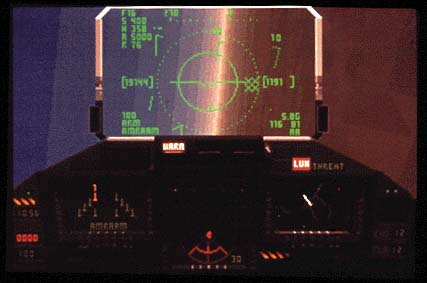

While approaching the ground target, two Mig 29s suddenly appear in the
threat indicator. The pilot switches for Ground Attack Mode to
Air-to-Air Mode, then locks and fires two AAAM missiles, which speed
unerringly toward a destructive conclusion. A SAM lights up the threat
indicator: the pilot turns so the missile is approaching on his 3-6
line, drips a few chaff, and turns into the path of the missile. As the
SAM runs out of fuel and drops to earth, the pilot returns to his attack
pattern, toggles laser targeting, starts the iron death to its
destination, pulls his left hand throttle back to 60 percent, and opens
the air-brake boards. When the first laser-guided bomb, a second is let
loose on a different building in the target zone, and it is time to go
home. Ainít technology grand?!

TFX allows a computer jockey to pilot the Nighthawk F-117A Stealth Fighter, the canard wing equipped Eurofighter 2000, and the stealth capable Lockheed F-22 Superstar. The player can also put hands on high-tech armament such as the not-yet-released 124-mile range AAAM and AAARM missiles with speeds of Mach 6 and 5, respectively. What a rush.
TFX uses high-quality, real-time generated three dimensional (3D) graphics for ground and air objects, scenery, and targets. This is a far cry from the original F-29 Retaliator simulator produced by Martin Kenwright.
TFX plays in arcade mode, similar to "instant action" in other sims, with five levels of progressively increasing difficulty, quick in-and-out battles, and automatic arming. Access to tour-of-duty and flash point story lines is through the completion of 10 United Nations training missions, which familiarize a would-be pilot with the operations of weapons and systems. There is also a bypass sequence that lets you jump into any mission in the game.
Tour-of-duty mission involve too-brief briefings and World Wide News Network coverage of events based in Somalia, Iraq, Yugoslavia, the South Atlantic, Libya, United States, and Columbia. Five Flash Point mission scenarios revolve around an "interactive soap opera" story line, similar to those in Strike Commander. If the over 200 pre-programmed missions available need supplementation, the UN Commander mission editor plans and saves custom mission s form over five million square miles of digitized terrain from geo-survey data and satellite pictures.
Choose from 18 weapons, including laser-guided bombs, and missile technology in development, such as the AAM. The cruise and Maverick missile systems are difficult to use, but the air-to-air AAAM wonít miss even the most agile enemy fighter, and the game seems to have been built around the laser guided bomb system which allows the player to pinpoint bomb targets. There are over 74 separate configurations for armament and control.
The views are spectacular, especially the virtual Cockpit Mode which allows the pilot to slowly turn his head through a 360-degree arc, with all the parts of the plane and exterior in 3D. Many players may be upset that there is no target tracking mode nor the ability to pan to an up view.
The high-resolution graphics are graced with many little details, like
graffiti under the bridges, and superb weather effects, like snow and
rain. However, overall, the shaded gray-and-olive world is boring on
long flights. Thankfully, these can be bypassed with a time compression
key.

Control keys are unreliable. The 98-page unindexed manual is occasionally brilliant, but not up to the standards set by Microprose and Spectrum Holobyte, who put in immense detail concerning the plane, the tactical situation, and the history of flight. Too bad.
TFX lacks the coordinated precision and cooperative fighting abilities seen in other flight simulators. The comprehensive, all-directional radar, malfunctioning cruise missiles and Mavericks, incomplete manual, all too short briefings, and poor in-flight mapping system make this a guarded buy.
On the other hand it is a remarkable flight simulator with complex and advanced controls, engaging music by Barry Leach, 700 KB of speech, accurate flight models, wonderfully rendered 3D graphics, a virtual cockpit, and 3D-capable enemy artificial intelligence. TFX provides the chance to fly some of the most high-tech, advanced ordnance in the world. So sit back and enjoy this good flight simulation. B-
Flying Tips: Martin Kenwright, managing director, Digital Image Design, a native Liverpudlian, an art college grad who enjoys driving his TVR Griffith Chimera sports car, is surprised that he has a staff of 20 working on new projects quite a step up from programming F-29 in his bedroom.
Martin suggests flying under bridges to read the graffiti and ejecting upside down form the plane to view the disemboweled body sequences. He most enjoys the real-world feeling he gets with flying a TFX mission, "taking off in a stealth bomber at night and flying toward the ever-enlarging Adriatic sea, moving through a cloud bank, approaching the target with its city lights, watching the AAA come up around the ship, fueling mid-air, and returning home to read the Herald Tribune coverage."
"Before you know it, you have spent two hours in the air, and you really feel like you have done something."
Mulitplayer: Single player game
References:
Al Giovetti, Electronic Games, volume 2, number 10, July, 1994, pg. 78, B-, 82%.